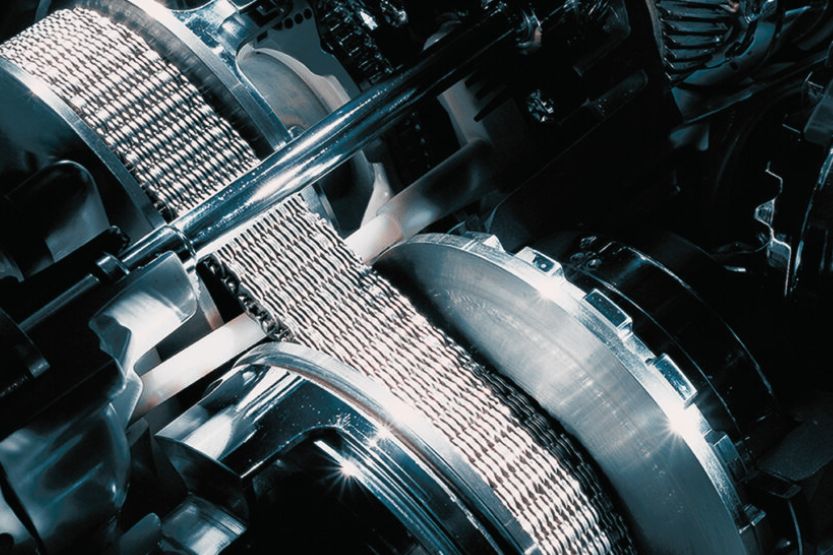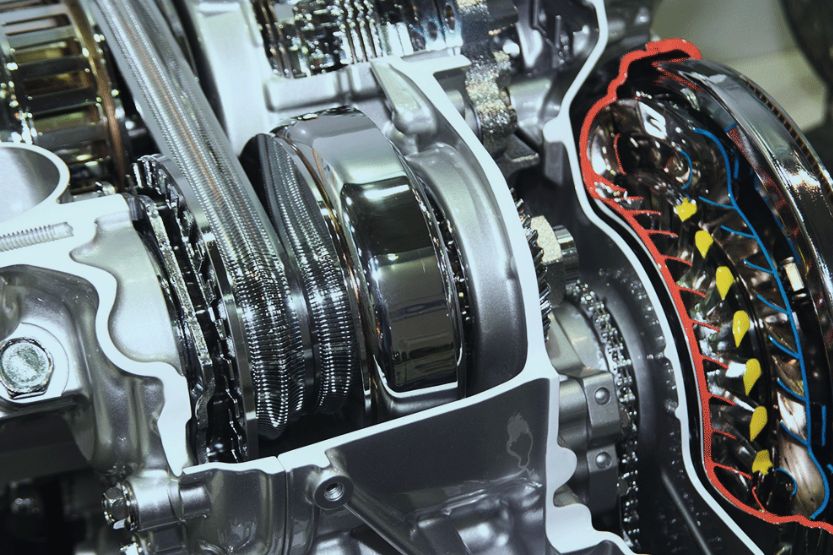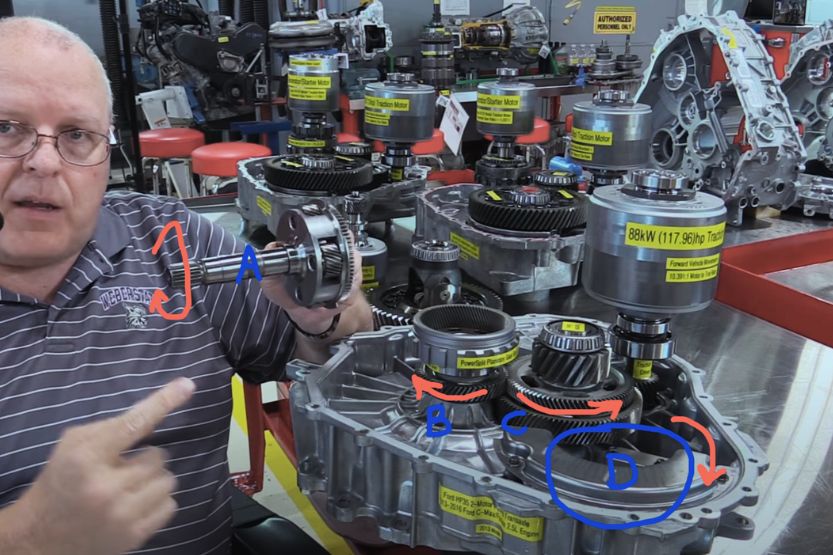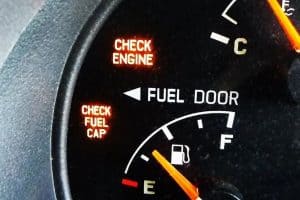A car with an eCVT transmission offers more than what cars with traditional automatic and even CVT transmission can offer. In this article, I’ll discuss eCVT – what is it? How does it work?
In an eCVT transmission, instead of belts and pulleys such as those used in CVTs, electric motors are used to control the speeds of the planetary gear components. The eCVT is a smart transmission system that offers an infinite number of gear ratios.
An eCVT transmission constantly analyzes the vehicle’s speed, driver input, and engine power and chooses the most efficient gear ratio for every moment. As such, it is one of the transmission systems that offers the best fuel economy.
Read on to learn more about eCVT, what it is, how it works, and how it compares with CVT.
eCVT Transmission Overview

Standard CVT Transmission Uses Belts and Pulleys to Simulate the Shifting of Gears
The standard CVT transmission uses belts and pulleys to simulate the shifting of gears in regular automatic transmissions. The new eCVT has already upgraded the CVT transmission. These two types of transmissions may appear to be fundamentally the same.
eCVT Uses Electric Motors to Control the Gear’s Speed
But there is a big difference between them. Instead of using the belts and pulleys of the standard CVT, an eCVT transmission uses electric motors/generators to control the speeds of the planetary gear components.
The eCVT, as some people have described it, is a more intelligent transmission system offering an infinite number of gear ratios.
It is smart because it can constantly analyze the road conditions, the driver’s input, and the vehicle’s speed to choose the most efficient gear ratio at every moment.
eCVT and CVT Meaning
eCVT stands for Electronic Continuously Variable Transmission. As you may have already guessed, its predecessor, the CVT, means Continuously Variable Transmission. If you consider their names, it would appear that they are similar.
Both transmissions can be automatic since the driver does not need to shift the gears physically. It is the transmission itself that chooses the gears as the vehicle is being driven.
The automatic transmission was invented to make driving easier. But the evolution of the transmission system didn’t stop there because there’s one major drawback with automatic transmission – it consumes more fuel than a manual transmission.
CVT Runs Like an Automatic Transmission But Consumes Less Gas
In answer to that, car manufacturers invented the CVT transmission. It runs like an automatic, but it consumes less gas. The development of the CVT was spurred by the quest to improve the performance of small cars and fuel economy.
eCVT Is a More Improved CVT
Not satisfied with the benefits of the CVT, car makers developed a more improved CVT – the eCVT. One car manufacturer, Subaru, developed an eCVT that combines the steel belt drive system that uses standard synchromeshes with a magnetic powder clutch that is electronically controlled.
These technological innovations produced a transmission system capable of moving a vehicle forward or backward using a changeover mechanism combined with simple hydraulic control valves.
Transmission Light – What Is It? And What Does It Mean?
How Does eCVT Work?
Does Not Work with Fixed Gear Ratios
The eCVT can be operated at its most efficient speed to either charge the batteries or propel the vehicle because it does not work with fixed gear ratios.
If the vehicle’s ECU sees that the motor is not required at a particular time, it will turn off. In its place, the ECU will use the twin-input eCVT to direct power from the electric motors to the wheels.
Better Driver Engagement
Driver engagement is better with a vehicle equipped with an eCVT. The eCVT can do this in two ways. One way is to equip an eCVT with a sequential function that can create the feeling of changing the gear ratios manually.
This type of eCVT can provide a closer match between increases in the engine speed and the vehicle. When the car slows down, it can also give a stepped engine braking force.
The other way is by equipping the eCVT with a sports mode. This mode can change the feeling of dynamic performance by increasing the speed of the engine more rapidly during acceleration.
Capable of Monitoring the Driver’s Behavior
One of the remarkable features of an eCVT is its ability to monitor the driver’s behavior. Based on the driver’s movements, the eCVT optimizes the interaction between the transmission and the engine to give the best fuel economy and performance.
As a result, you can achieve around 10% fuel savings compared to a regular four-speed automatic transmission. The eCVT utilizes a selector lever like what is used on automatic transmissions.
When you put the selector to D, you can start driving away. The transmission will operate at its optimum ratio regardless of the vehicle’s speed. With regards to acceleration from a standing start, an eCVT is generally much faster than a vehicle with manual transmission.
Provides a Broader Ratio Span
While the vehicle is running, the eCVT provides a broader ratio span, roughly the same as the gear ratios of a six-speed manual. In theory, this should give remarkable fuel economy if the engine runs at its optimum speed while carrying a load for a given street speed.
However, frictional losses in the transmission eat up a good amount of energy. So, in the real world, cars with eCVT transmissions are less fuel efficient by around 5% compared to cars with manual shifters.
Toyota’s eCVT
Toyota has its version of the eCVT. It uses two motor-generator units, a planetary gear set, and a smart transmission control unit to transmit power smoothly to the wheels.
Toyota uses its eCVT only in its hybrid vehicles, where power is delivered solely by a battery (pure EV), engine plus battery (hybrid mode), and engine (when the battery is discharged).
Again, what’s the difference between CVT and eCVT? Once you push the gas pedal, the CVT adjusts the engine to maintain an efficient RPM. In contrast, the electric motor or generator controls the speed if you have an eCVT.
What Is the Difference Between eCVT and Standard CVT?

While they may have similar names, CVT and eCVT are very different. CVT was first developed before the eCVT. So, you can say that the new eCVT is the successor of the standard CVT.
Toyota’s eCVT is considerably different from a standard CVT that is belt and chain driven. An eCVT is more similar to the conventional step type automatic transmissions.
Let’s discuss their difference:
CVT
Uses a Metal Belt or Chain That Runs Between Two Pulleys
A standard CVT manages the engine’s rpm differently from an automatic transmission. Instead of gears, the conventional CVT uses a metal belt or chain that runs between two pulleys.
The two pulleys are made so they can move closer to each other or spread apart wider. Hydraulic pressure is used by the system that forces the chain or belt to ride lower or higher in the pulleys.
To help you visualize how this setup works, consider how a chain operates across the gears of an ordinary 10-speed bicycle. It is very similar to how a standard CVT works.
One Cone Is Connected to the Engine’s Output Shaft
In a CVT, one cone is connected to the engine’s output shaft. The other cone is directing power to the driveshaft and drive wheels. As the pulley moves closer or further apart, the gear ratios change. This causes the belt or chain to move up or down the sides of the two cones.
This movement will increase or decrease the diameter of the belt or chain. As this happens, the gear ratio is changed based on the power required. All these changes occur in real-time as the car is being driven.
Advantages of the Pulley-chain System
An advantage of this pulley-chain system is that the ECU can quickly and constantly adjust the pulleys to the required ratio of the moment so that peak efficiency is achieved since it is not limited physically by gears.
When you drive a CVT car, you step on the gas pedal, and the CVT will adjust to keep the engine running at its most efficient rpm while accelerating.
You won’t feel any rpm surges or bumps. The CVT can do this even when the car is climbing up a hill. It keeps the engine at its most efficient rpm. The CVT is the one that adjusts so the vehicle can go over the hill.
eCVT
The eCVT does not use any belt or chain, or variable pulleys. In place of these components, an eCVT uses electric motors or generators to control or adjust the speed of the planetary gears. This is how it is different from conventional CVTs.
This setup enables the eCVT to continuously change the gear ratio to maintain the engine rpm at its sweet spot. Driving a car with an eCVT transmission is similar to regular CVTs since the driver won’t feel any step change which is very common with automatic transmissions.
What Are the Common Failures in a Nissan CVT Transmission?
Frequently Asked Questions

The topic of eCVT and how it works is quite technical. So, you may still have questions in your mind that you want to be answered. Keep on reading. You may find your answers below:
What Is an eCVT Transmission?
The word eCVT stands for electronic continuous variable transmission. While it also carries the term CVT in its name, an eCVT is very different from a conventional CVT. An eCVT uses various components to control the speed of a vehicle. The principle of operation is also different from a CVT.
Some people call the eCVT a smart transmission system. Perhaps they call it ‘smart’ because it constantly analyzes the vehicle’s speed, the engine’s power, the driver’s movements, and the road conditions to select the most efficient gear ratio for a particular moment.
How Is a CVT Different from an eCVT?
A CVT and an eCVT are both classified as automatic transmissions. Their primary difference lies in how they transfer power from the engine to the wheels. A CVT uses two pulleys with a belt or chain between them.
The drive pulley transmits torque from the engine while the driven pulley transfers the torque to the wheels.
In an eCVT, the system uses two electric motors/generators instead of pulleys and chain to transfer power from the engine to the wheels. There are no pulleys or chains in an eCVT.
Why Are CVT and eCVT Fuel Efficient?
The CVT and the eCVT alter the relationship between the engine’s speed and the power transferred to the wheels. So these two types of continuously variable transmission make it possible that no excess fuel will be used more than what is required at any time.
How Does an eCVT Work?
An eCVT tracks the behavior of the driver. The eCVT will optimize the interaction between the engine and the transmission based on how the driver drives the vehicle. In this way, it can provide the best fuel economy and performance at any one time.
When the driver puts the gear selector to D, they can drive straight away. The eCVT will operate at its most efficient gear ratio for the range of speed the engine is running. As for the acceleration from a standstill, the eCVT is typically much faster than a vehicle with manual transmission.
The eCVT can be operated at the most efficient speed to either charge the batteries or propel the vehicle because it does not work with fixed gear ratios.
If the vehicle’s ECU determines that the motor is not required at a certain time, it can be turned off. Instead, the ECU will use the twin-input eCVT to direct power from the electric motors to the wheels.
A vehicle equipped with an eCVT offers improved driver engagement. The eCVT can do this in two ways. One way is to equip an eCVT with a sequential function. This will create the feeling of changing the gear ratios manually.
The other way is by providing the eCVT with a sports mode. This mode increases the engine speed more quickly during acceleration giving the driver the feeling of dynamic performance.
What Is the Fuel Efficiency of an eCVT?
With its smart transmission system, an eCVT can realize approximately 10% fuel savings compared to a car with a four-speed automatic transmission.
In Closing: What Is eCVT Transmission and How Does It Work?
Instead of belts and pulleys like regular CVTs, an eCVT uses electric motors to control the speeds of the planetary gear components. It is a smart transmission system that offers an infinite number of gear ratios.
It is an intelligent transmission system because it constantly analyses the vehicle speed, the driver’s input, and the engine’s power delivery can select the most efficient gear ratio for each specific moment. This makes the eCVT the best if you are after fuel economy.
Read next:

![What Is a Transmission Flush? [All About Transmission Flushes] what is a transmission flush](https://roadsumo.com/wp-content/uploads/2021/12/what-is-a-transmission-flush-150x150.jpg)

![Does Fix-a-Flat Work? [Is Fix-a-Flat Effective?] does fix-a-flat work](https://roadsumo.com/wp-content/uploads/2021/11/does-fix-a-flat-work-150x150.jpg)





